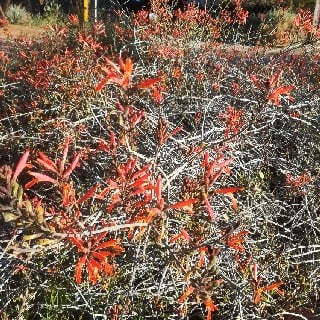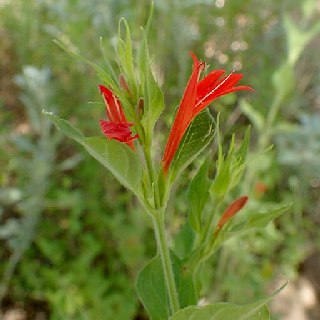If want to attract hummingbirds into your yard, chuparosa is a “must have” shrub to consider. It’s so good at attracting hummingbirds that its name means “hummingbird” in Spanish. Here’s everything you need to know about growing this Sonoran Desert native as a desert landscape plant.

Chuparosa (Justicia californica) is a medium size shrub with small gray-green leaves and larger, vivid red tubular flowers that hummingbirds can’t resist.
Its foliage is sparse, but plants make up for it in flowers. Chuparosa can be so dense with flowers, that its leaves are obscured.
As a Sonoran Desert native, this plant can tolerate desert full sun, heat, and cold. In its native habitat, it can survive on as little as 3″ of rain per year.
One of the main reasons gardeners grow this plant is to help out our favorite feathered friends. Since plants bloom on and off throughout the year, they provide nectar when there isn’t much else available. They are also larval hosts for several butterfly species.
Why I Like This Plant
- Red flowers almost all year
- Hummingbirds love it!
- Low maintenance
- No thorns, low litter
Fun Fact!
Rufous hummingbirds that migrate from Mexico
to Alaska, follow the chuparosa’s bloom path
as they travel through the desert southwest.
Things to Watch Out For
Chuparosa is semi-deciduous, meaning it loses its leaves when facing drought or cold. It intermittently will have few or no leaves on and off throughout the year.
As you can see in this picture below, it’s a wild-looking, rather than manicured plant.

This may not be the look you’re going for if you want a tidy shrub that you can prune into a more formal shape. If you live in an urban or suburban area, it might not conform to your neighborhood’s norms or your HOA’s rules. In that case, it might be a better choice for your backyard than your front yard.
Optimal Growing Conditions
If you’re thinking of adding a chuparosa to your garden, you need to find a suitable place that will keep your plant healthy and looking good… while minimizing maintenance for you.
Here are the key factors to keep in mind.
Temperature
Chuparosa should be grown in USDA Hardiness Zones 8 – 10. It’s a heat loving plant that tolerates cold down to the 20s. Plants can survive a quick dip as low as 22℉, but may be damaged by prolonged freezes below 26℉.
Sun Exposure
As a Sonoran Desert native, chuparosa likes full sun and even the reflected sun off walls and buildings. They tolerate some partial shade, but with too much shade they’ll get leggy and have fewer flowers.
Size and Growth Rate
Chuparosa grows moderately fast. Plants typically reach a size of 4 feet tall by 5 feet wide. But a plant’s size and growth rate largely depend on how much water it receives.
Plants bloom most heavily in the spring, but often flower on and off throughout the year.

Soil
Chuparosa is not particular about soil. It grows well in most native soils — rocky, sandy, gravelly — provided it’s well-draining.
Other Location Considerations
Since it is non-toxic, has no thorns, and is low-litter, it’s a plant you can place near a sidewalk, driveway, or patio, or anywhere else it might come in contact with people or pets.
Chuparosa:
The Essentials
| Common Name | Chuparosa |
| Scientific Name | Justicia californica |
| Origin | Sonoran Desert |
| Plant Type | Semi-deciduous shrub |
| USDA Zones | Zones 8 – 10 |
| Cold Hardiness | To 26℉ |
| Flower Color | Red |
| Flower Season | Throughout the year |
| Mature Size | 4’ high x 5’ wide |
| Growth Rate | Moderate |
| Sun Tolerance | Full, reflected sun |
| Water Needs | Moderate |
| Pests & Diseases | None |
| Garden Friendly | No thorns |
| Wildlife | Attracts hummingbirds, butterflies Rabbit resistant |
How to Plant
The rule of thumb when planting any shrub in the desert is to dig a hole three times as wide as the root ball but no deeper. Amending the soil is not recommended. Counterintuitively, backfilling with the same native soil you just dug up helps your plant develop a stronger root system.
When to Plant
The best time to plant chuparosa is in the fall. This gives your shrub three seasons to grow roots and get established before the following summer.
The second best time is in spring, the earlier the better. This still gives your plant time to get established before the intense heat of June arrives.
How to Care for Chuparosa
Whether you’ve recently planted a chuparosa or have an existing plant in your yard, here’s how to take care of it to keep it healthy and looking its best.
How to Water New Plants
Once you’ve got your shrub in the ground, watering is your most immediate concern. Here is the recommended watering schedule for new shrubs planted in the spring or fall.
| Weeks 1 & 2 | Every 3 – 4 days |
| Weeks 3 & 4 | Every 5 – 7 days |
| Weeks 5 & 6 | Every 7 – 10 days |
| Weeks 7 & 8 | Every 10 – 14 days |
After week 8, gradually extend the time between waterings.
How to Water Established Plants
Once your plant is established, water it twice per month during the summer, and once per month the rest of the year. While plants can survive on rainfall alone, they’ll look better and keep their leaves longer with supplemental water.
However, don’t overwater this plant. Too much water results in fast but weak growth and fewer flowers.
Should You Fertilize?
There is no need to fertilize chuparosa. This plant has evolved to get all the nutrients it needs from the surrounding desert soil.
How to Prune
Chuparosa doesn’t need regular pruning. Remove any frost damage in early spring and lightly trim to shape or reduce legginess in the late spring.
Don’t try to prune this into a hedge or make it look like a manicured shrub. It won’t be happy. However, this is a shrub that responds well to a severe, rejuvenation prune once every 3 to 4 years.
Don’t Confuse Chuparosa With…
Chuparosa (Justicia californica) is sometimes confused with red justicia (Justicia candicans). These plants have a lot in common.
Both are members of the Justicia genus, are Sonoran Desert natives that are grown as landscape plants, and have tubular red flowers that attract hummingbirds.
However, red justicia is a lusher, greener shrub that has a more manicured look. It grows in part shade, requires more water, and keeps its leaves most of the year except after freezes.

Plant Lover Facts
Chuparosa (Justicia californica) also goes by the common names beloperone and hummingbird bush. It can be found growing in washes in Arizona, California, and northwest Mexico.
Since it’s often leafless, its branches pick up the slack — they have the capacity to photosynthesize.
Flowers are usually vivid red, but some plants have yellow-orange flowers instead.
Chuparosa flowers are edible and somewhat sweet. I hear they make a delicious salad topping that tastes like cucumbers.
Did you enjoy this article?
Sign up for our weekly newsletter
where you’ll find more great info on creating &
maintaining a beautiful, carefree desert landscape.
Author Bio
Deane Alban is the creator of Southwest Gardener. She is a science writer with a bachelor’s degree in botany from the University of South Florida. Gardening is her lifelong passion. She’s been gardening in Tucson for over 15 years.

Photo Credits
Joshua Tree National Park, Public Domain
Arizona State University’s Virtual Library of Phoenix Landscape Plants
Stan Shebs, CC BY-SA 3.0, via Wikimedia Commons
Krzysztof Ziarnek, CC BY-SA 4.0, via Wikimedia Commons
